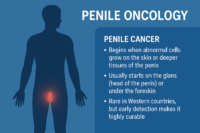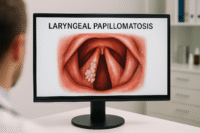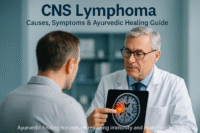Tal Sindoor is a traditional Ayurvedic mercury-based formulation known for its powerful action against deep-seated infections, chronic skin disorders, and certain sexually transmitted diseases. Unlike symptomatic treatments, Tal Sindoor targets the root imbalance of doshas (bioenergies), especially Kapha and Vata, and rejuvenates the body’s core immune strength through Rasayana action [1]. It is one of the most potent Kupipakwa Rasayanas (slow-cooked mineral medicines) mentioned in authoritative Ayurvedic treatises like Rasa Tarangini and Rasendra Chintamani [2].
This compound contains purified Parad (mercury), Gandhak (sulfur), and Harital (arsenic trisulfide), each of which undergoes a complex Shodhana (detoxification) process to ensure safety and bioavailability [3]. When properly prepared, Tal Sindoor transforms into a fine red powder with deep tissue penetration properties, allowing it to reach chronic pathological sites like latent infections, granulomas, ulcerative lesions, and even post-tubercular tissues [4].
While it may appear controversial from a modern toxicology standpoint, classical Ayurveda insists that when the purification and cooking (Kupipakwa) process is strictly followed, Tal Sindoor becomes free of toxicity and extremely therapeutic [5]. Modern researchers are now revisiting these mineral-metallic medicines, particularly in the context of drug-resistant infections and autoimmune skin conditions [6].
Tal Sindoor is not a general tonic. It is reserved for conditions that are non-responsive to herbal treatments, particularly herpes, leprosy, vitiligo, genital ulcers, tuberculosis, and chronic wounds. Its unique combination of Krimighna (anti-parasitic), Kusthaghna (skin disease-reducing), Vishaghna (anti-toxic), and Rasayana (rejuvenative) properties makes it one of the most complex and powerful formulations in Rasa Shastra [7].
When administered with the right Anupana (vehicle), such as honey, ghee, or decoctions like Guduchi, Tal Sindoor not only eliminates the disease but also restores lost vitality and immune function, especially in long-standing viral or bacterial diseases [8]. Today, under the care of certified Ayurvedic doctors, Tal Sindoor is witnessing a clinical resurgence as an adjunct therapy for infections where conventional antibiotics fail or where chronic immune fatigue persists [9].
Ayurvedic Composition and Preparation
Tal Sindoor is a Kupipakwa Rasayana prepared through one of the most sophisticated alchemical processes described in Ayurveda. Its core ingredients are Shuddha Parad (purified mercury), Shuddha Gandhak (purified sulfur), and Shuddha Harital (purified orpiment, i.e., arsenic trisulfide), each subjected to elaborate Shodhana protocols using lime water, cow’s urine, Kushmanda juice, and Triphala decoction [1]. These detoxification methods are critical to transform inherently toxic substances into bioavailable, Rasayana-grade ingredients.
The formulation is then subjected to a Kupipakwa process—a sealed glass-bottle heating method—that carefully fuses Parad, Gandhak, and Harital at precisely controlled temperatures for several hours. This process converts the mixture into a bright red Sindoor (fine powder), indicating correct formation of the compound without free mercury residues [2]. This Sindoor undergoes no further grinding; it is directly collected once the sublimation and condensation cycle is complete.
The transformation of these metals and minerals is not merely physical but alchemical. Parad acts as a Yogavahi, enhancing the bioavailability of the other components, while Gandhak neutralizes Parad’s potential toxicity. Harital provides the potent Krimighna (anti-parasitic and anti-microbial) effect and assists in breaking down stagnant Doshas and endotoxins at the tissue level [3].
Classical texts emphasize that improperly prepared Tal Sindoor becomes a Visha (poison), while correctly purified and fused Tal Sindoor turns into a life-enhancing Rasayana with extraordinary therapeutic reach [4]. Therefore, traditional Ayurvedic texts like Rasa Tarangini (Chapter 18), Bhaishajya Ratnavali (Rasayana Prakarana), and Rasendra Chintamani outline each step of the preparation with utmost precision [5].
The final product—when completed correctly—possesses micro-particle size (Sookshma), intense heat potency (Ushna Virya), and the ability to penetrate deep into Dhatus (body tissues), targeting long-standing pathologies including viral latency, chronic ulceration, and infected sinuses [6]. This unique capability to travel through micro-channels (Srotas) and remove accumulated metabolic wastes (Ama) is what distinguishes Tal Sindoor from herbal-only formulations [7].
Classical Ayurvedic Properties
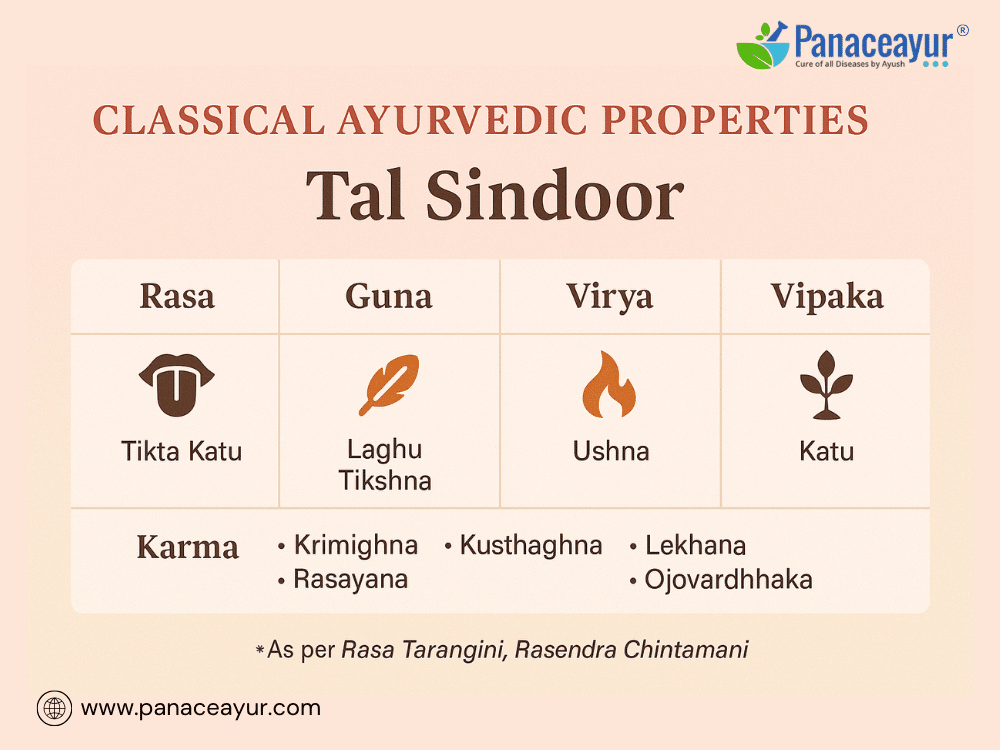
In Ayurvedic pharmacology, Tal Sindoor is classified under Rasaushadhi—a category of potent mineral formulations designed for chronic and obstinate diseases. Its actions are deeply rooted in the properties of its ingredients and the alchemical transformation they undergo during preparation. According to Rasa Tarangini and Rasendra Chintamani, the final product exhibits powerful Tikshna (penetrating) and Sookshma (subtle) Guna, enabling it to act at a microscopic level within tissues [1].
The Rasa (taste) of Tal Sindoor is classified as Tikta (bitter) and Katu (pungent)—two tastes known for their detoxifying, digestive, and antimicrobial properties. These tastes help to cleanse the Rasa Dhatu (plasma) and Rakta Dhatu (blood) where chronic toxins, viruses, and parasites tend to lodge [2].
Its Guna (qualities) include Laghu (lightness) and Tikshna (sharpness). Laghu helps it to be rapidly absorbed, while Tikshna enables it to pierce through obstructions in the microchannels (Srotas). This makes it highly effective in chronic infections where immune cells and antimicrobials cannot easily reach [3].
The Virya (potency) is Ushna (hot), which supports Agni (digestive and metabolic fire) and helps liquefy and eliminate accumulated Kapha and Ama (toxins). This property is crucial in managing conditions like tuberculosis, leprosy, herpes, and chronic fevers, where cold-natured Kapha dominance leads to sluggish metabolism and tissue congestion [4].
Its Vipaka (post-digestive effect) is Katu, confirming its scraping, drying, and detoxifying impact on the system even after digestion. This Katu Vipaka ensures continued elimination of metabolic wastes and prevents further buildup of toxins or viral residue [5].
Tal Sindoor is further classified as having the following therapeutic Karmas (actions):
- Krimighna – Destroys hidden pathogens and parasites
- Kusthaghna – Effective against chronic and hard-to-heal skin disorders
- Lekhana – Scrapes toxins from tissues and clears microchannels
- Rasayana – Rejuvenates the system, especially after chronic disease
- Ojovardhaka – Enhances Ojas (vital essence), contributing to long-term immunity [6]
These classical qualities, when matched with the disease pathology, explain why Tal Sindoor is prescribed selectively—particularly when herbal or dietary interventions have failed and a deeper tissue-level correction is required [7].
Therapeutic Uses of Tal Sindoor
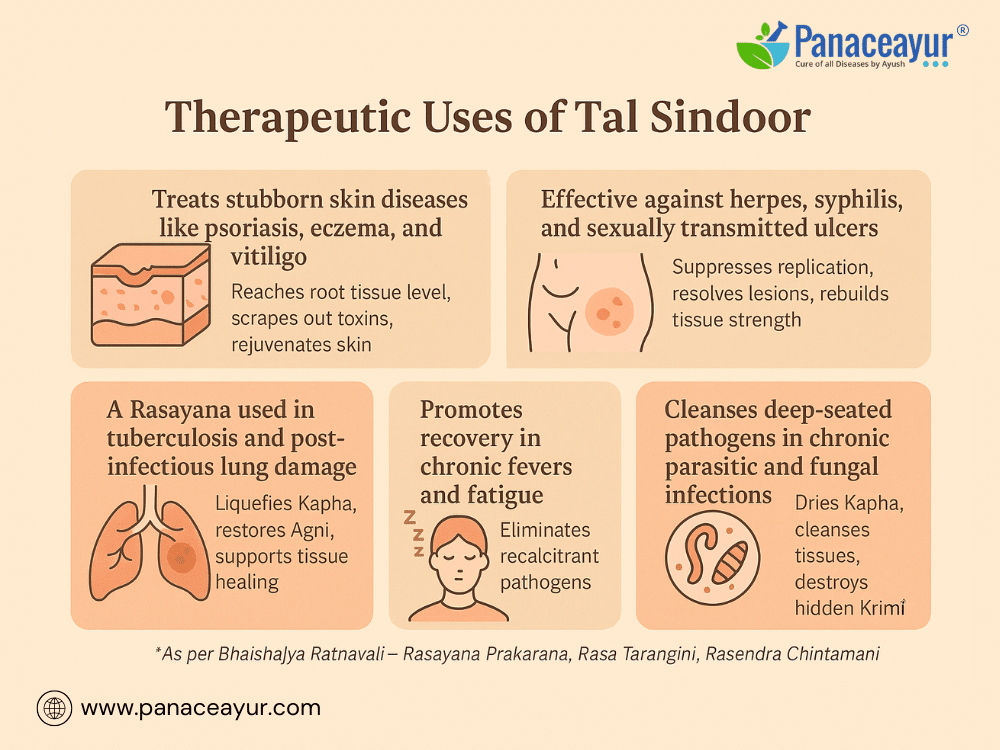
Tal Sindoor is not a general-purpose Ayurvedic remedy. It is reserved for complex, chronic, and treatment-resistant conditions that demand deeper tissue penetration and Rasayana rejuvenation. Its clinical relevance spans from autoimmune skin diseases to deep-seated infections and chronic viral states.
Treats stubborn skin diseases like psoriasis, eczema, and vitiligo
Tal Sindoor is most commonly prescribed in Ayurveda for Kushta Roga, a broad category that includes long-standing dermatoses such as psoriasis, atopic dermatitis, and vitiligo. These conditions often have deep-seated imbalances in Rasa and Rakta Dhatus (plasma and blood tissues), compounded by Ama (toxins) and latent microbial triggers. Due to its sharp, penetrating properties (Tikshna Guna), Tal Sindoor reaches the root tissue level, scrapes out pathological elements (Lekhana Karma), and simultaneously rejuvenates the skin through its Rasayana effect [1].
Effective against herpes, syphilis, and sexually transmitted ulcers
The classical term Upadansha refers to a group of sexually transmitted conditions involving genital ulcers, foul discharge, pain, and latent tissue damage. In modern terms, this includes herpes simplex, syphilis, and possibly HPV-related lesions. Tal Sindoor’s combination of Krimighna (anti-pathogenic) and Vishaghna (anti-toxic) properties, especially when combined with Gandhak Rasayan, allows it to suppress viral replication, resolve ulcerative lesions, and rebuild tissue strength from within [2].
A Rasayana used in tuberculosis and post-infectious lung damage
In Rajayakshma, a term corresponding to tuberculosis, Tal Sindoor is part of a Rasayana-based post-recovery protocol. It helps rebuild lost strength, restore appetite, and clear chronic congestion in the lungs. Its Ushna Virya (hot potency) liquefies Kapha blockages, and when co-administered with Abhrak Bhasma or Swarna Makshik Bhasma, it supports respiratory tissue regeneration [3]. This combination is particularly useful in post-tubercular states or conditions involving chronic cough and wasting syndromes [4].
Promotes recovery in chronic fevers and fatigue syndromes
Tal Sindoor is traditionally indicated in Jirna Jwara—a term referring to chronic, low-grade fevers. These include undiagnosed fevers, post-viral fatigue (similar to long COVID or Epstein-Barr reactivation), or conditions where Ama and immune suppression lead to subclinical infections. Its bitter-pungent profile, along with detoxifying and immunostimulant effects, helps rekindle digestive fire (Agnideepana), eliminate hidden Krimi (pathogens), and restore vitality [5].
Cleanses deep-seated pathogens in chronic parasitic and fungal infections
In Krimi Roga, Tal Sindoor is used to target not only intestinal parasites but systemic infections hiding in tissues—similar to modern concepts of fungal biofilms, latent bacteria, and intracellular viruses. It has a scraping action (Lekhana) that clears blocked microchannels (Srotas), allowing immune factors to reach infected areas. Clinical parallels include recurrent pustules, sinus tracts, or unresolved abscesses that persist despite antibiotics or antifungals [6].
Helpful in benign cysts, granulomas, and early mass formation
While not classified as a cancer drug, Tal Sindoor has been mentioned in the context of Granthi and Arbuda (benign tumors and cysts) in classical Rasashastra texts like Rasendra Sara Sangraha. Its action of drying and reducing Kapha accumulation makes it useful in managing small cystic masses, lipomas, or early glandular swellings that are non-malignant. However, such use must be done under expert Ayurvedic supervision with proper diagnostics [7].
A last-resort formulation when herbal therapies fail
Due to its mineral base and deep Rasayana potential, Tal Sindoor is not a first-line remedy. It is typically prescribed after herbal treatments, diet, and detox therapies have failed, especially when the disease persists due to Dhatu-level vitiation (tissue pathology), immune fatigue, or latent infection. Used correctly, it does not just suppress symptoms but initiates profound cellular detoxification and immune reconstruction [8].
Ayurvedic Mode of Action & Biomedical Correlation
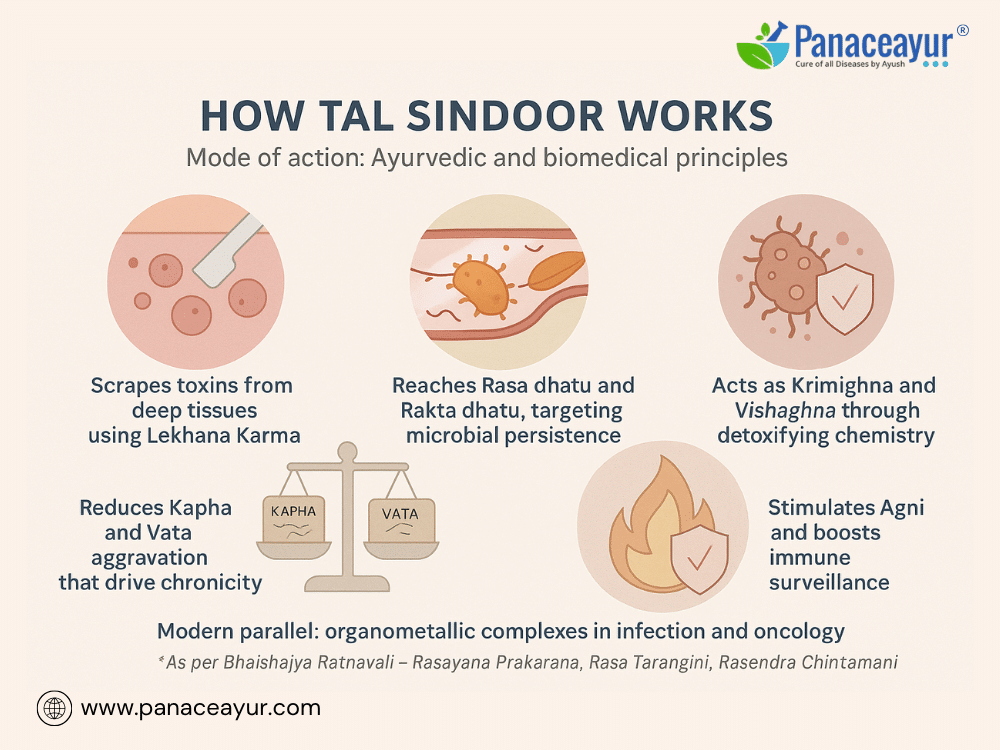
Tal Sindoor is one of the few Ayurvedic formulations whose mechanism of action spans both traditional Rasashastra and modern biomedical principles. While its classical understanding relies on dosha balancing, tissue detoxification, and Rasayana rejuvenation, recent research suggests it may possess immune-modulatory, cytotoxic, and antimicrobial effects that contribute to its effectiveness in complex diseases.
Scrapes toxins from deep tissues using Lekhana Karma
According to classical Ayurvedic texts, Tal Sindoor works by penetrating Srotas (microchannels) and performing Lekhana Karma—a scraping and decongesting action that removes Ama (toxins), residual Kapha, and pathogenic buildup from tissues [1]. This is especially useful in chronic skin diseases and sinus tracts, where conventional therapies fail due to tissue-level blockage.
Reaches Rasadhatu and Raktadhatu, targeting microbial persistence
Its base minerals—Parad, Gandhak, and Harital—undergo specific Shodhana and Kupipakwa processes that transform them into Sookshma (ultrafine), Tikshna (sharp) particles. These properties allow Tal Sindoor to reach the Rasa (plasma) and Rakta (blood) dhatus—tissues commonly involved in autoimmune and infectious diseases [2]. The formulation can thus break through microbial biofilms, viral latency, and stagnant immune responses.
Reduces Kapha and Vata aggravation that drive chronicity
Most diseases indicated for Tal Sindoor involve aggravated Kapha (accumulated toxins and secretions) and Vata (disrupted flow and degeneration). Tal Sindoor’s Ushna Virya (hot potency) clears Kapha from lungs, sinuses, and ulcers, while its fine particles restore Vata-regulated circulation in affected tissues [3].
Acts as Krimighna and Vishaghna through detoxifying chemistry
From an Ayurvedic perspective, Tal Sindoor is Krimighna (destroys pathogens) and Vishaghna (neutralizes toxins). Modern correlation suggests that purified arsenic trisulfide (Harital) and mercury-sulfur complexes may exhibit cytotoxic effects on infected or inflamed cells, destroying pathogens without harming healthy tissue when used in microdoses [4].
Stimulates Agni and boosts immune surveillance
In chronic fevers and fatigue syndromes, Tal Sindoor rekindles Jatharagni and Dhatvagni (digestive and tissue-level metabolic fire), enhancing detoxification and nutrition delivery. Its Rasayana effect improves Ojas (vital energy) and immune resilience in immune-compromised patients [5].
Modern parallel: organometallic complexes in infection and oncology
Interestingly, the combination of mercury-sulfur-arsenic in Tal Sindoor resembles modern-day organometallic therapeutic strategies used in oncology (e.g., arsenic trioxide in leukemia) and antimicrobial research. These compounds exhibit low-dose cytotoxicity, immune modulation, and microbial inhibition, aligning with Ayurvedic claims of Krimighna and Rasayana efficacy [6].
This dual understanding of Tal Sindoor as both a biological cleanser and immune stimulant makes it a unique candidate for integrative approaches to chronic infections, autoimmune skin disorders, sexually transmitted diseases, and even post-viral rehabilitation.
This medicine, due to its fever-reducing, germ-killing, Kapha-reducing, and warm nature, effectively destroys pathogens in conditions like recurring fevers, intermittent fevers, tertiary fevers, quaternary fevers, and chronic fevers accompanied by chills. It burns accumulated phlegm and clears toxins from the blood, ultimately restoring balance and alleviating symptoms. When chronic fever results in complications such as inflammation, lethargy, chest pain, or body aches, this medicine helps resolve those conditions as well.
Since this formulation is warm, invigorating, and stimulates the heart, it is beneficial in cases of heart weakness or palpitations. It increases heart activity and improves circulation, which enhances oxygenation and relieves related symptoms. In conditions where phlegm accumulates in the lungs, leading to slow heart function, body pain, loss of appetite, pale skin, dizziness, and weakness, Tal Sindoor proves to be an effective treatment. (Based on Ayurvedic texts)
In situations where other medicines like Mall Sindoor or other sulfur-based preparations cannot be tolerated due to excessive Vata or Kapha aggravation, Tal Sindoor is recommended.
Important Notes: During the course of this treatment, it is important to include more ghee in the diet. It is advised to avoid spicy foods, oil, salt, jaggery, and sour substances. For those suffering from joint pain, milk and salt should be avoided. In cases of diabetes, salt should not be consumed at all.
Dosage and Anupana (Adjuvants)
The dosage of Tal Sindoor must be carefully individualized based on the patient’s constitution (Prakriti), disease chronicity, tissue involvement, and immune status. Ayurvedic texts consistently emphasize that this formulation should only be administered under the guidance of a qualified Vaidya due to its potent mineral content and systemic reach.
Standard classical dose: 15–60 mg once or twice daily
As per Bhaishajya Ratnavali and Rasa Tarangini, the therapeutic dose of Tal Sindoor typically ranges from 15 mg to 60 mg, administered once or twice daily depending on the severity of the disease and patient tolerance [1]. For chronic infections and skin diseases, a longer course under supervision is often required.
Anupana (vehicle) enhances direction and safety
The adjuvant plays a key role in targeting the effect of Tal Sindoor to specific tissues and balancing its Ushna (hot) potency.
- Honey (Madhu): Used in herpes, ulcers, and skin disorders. Acts as a Yogavahi (carrier) and immune stimulant.
- Ghee or butter: Recommended in post-tubercular weakness or if patient shows signs of burning sensation. Helps cool down excess Ushna Virya.
- Guduchi Swarasa (Tinospora cordifolia juice): Used in chronic fevers, fatigue, and immune dysfunction. Enhances Rasayana and antipyretic action.
- Arogyavardhini or Gandhak Rasayan: Given alongside in hepatic or syphilitic conditions for synergistic detoxification [2].
Timing and administration
- Preferably administered after meals, especially when combined with ghee or butter to buffer gastric effects.
- In fevers or weak digestion, taken on empty stomach with Guduchi to kindle Agni and clear Ama.
- Duration: Commonly used in 30–90 day courses, based on Rasayana protocol for chronic illness management [3].
Customizing per patient’s doshic profile
- Vata-dominant patients: Use with warm ghee or milk decoctions to prevent dryness or anxiety.
- Kapha-dominant patients: Combine with honey and herbs like Pippali or Trikatu to aid absorption and stimulate Agni.
- Pitta-dominant patients: Use cautiously with cooling adjuvants like butter or Amalaki to avoid Pitta aggravation.
Strict precautions required
Tal Sindoor should not be administered to:
- Children under 12 years
- Pregnant or lactating women
- Patients with uncontrolled bleeding disorders
- Those without prior Shodhana (body detoxification) if symptoms suggest excess Ama or Manda Agni
If mishandled, overdose or improper combination can lead to metallic toxicity or unwanted Ushna-induced reactions. Hence, classical guidelines and clinical judgement must both be applied [4].
Synergistic Combinations
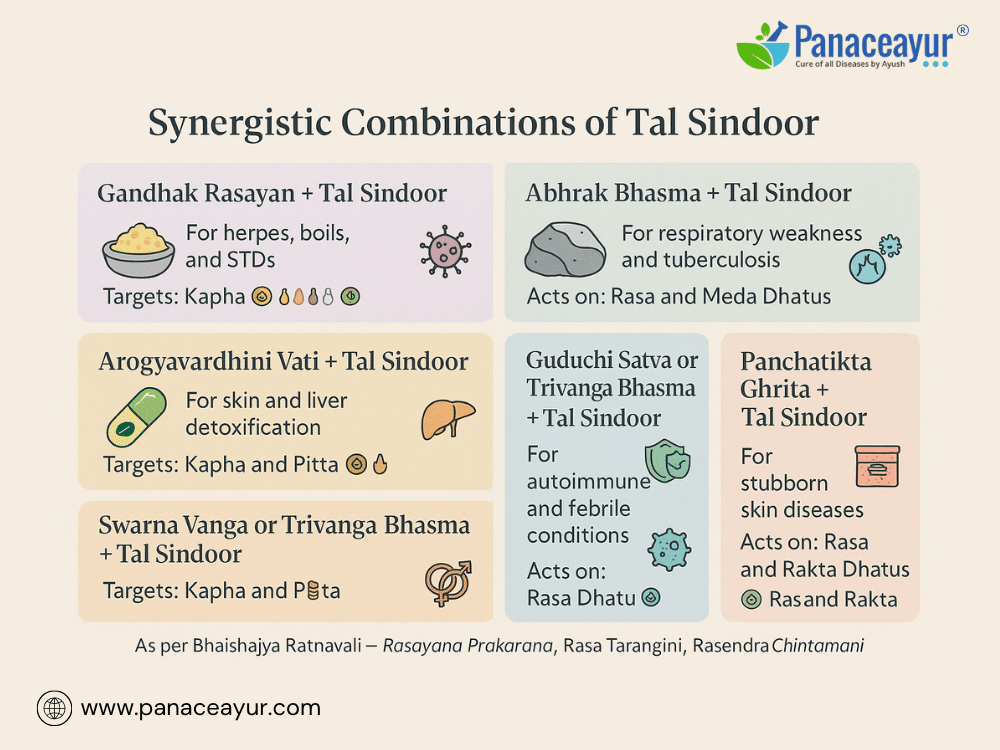
Tal Sindoor rarely works in isolation. In classical and clinical practice, it is almost always paired with other Rasaushadhi or herbal Rasayanas to enhance efficacy, reduce potential side effects, and direct its action toward specific tissues or systems. These combinations are not arbitrary—they are strategically prescribed based on doshic imbalance, disease site, and tissue involvement.
1. Gandhak Rasayan + Tal Sindoor: For herpes, boils, and STDs
This is a classical combination used in Upadansha (herpes and sexually transmitted diseases) and recurrent pustular skin eruptions. Gandhak Rasayan works as a cooling, rejuvenating sulfur-based Rasayana that buffers Tal Sindoor’s heat while enhancing its Krimighna (pathogen-killing) action. Especially beneficial in genital herpes, syphilitic ulcers, and chronic abscesses [1].
2. Abhrak Bhasma + Tal Sindoor: For respiratory weakness and tuberculosis
Abhrak Bhasma, known for its ability to penetrate deep tissues and rebuild all seven Dhatus, is often combined with Tal Sindoor in cases of Rajayakshma (tuberculosis), bronchial asthma, and post-COVID lung fibrosis. Tal Sindoor clears Kapha blockages, while Abhrak Bhasma restores strength and reverses tissue depletion [2].
3. Arogyavardhini Vati + Tal Sindoor: For skin and liver detoxification
When skin diseases have a hepatic origin—such as eczema, psoriasis, or jaundice-linked dermatoses—this combination works exceptionally well. Arogyavardhini supports liver cleansing and Pitta-Kapha balancing, while Tal Sindoor clears skin tissue and prevents recurrence [3].
4. Swarna Vanga or Trivanga Bhasma + Tal Sindoor: For urogenital infections
In chronic urinary tract infections, genital ulcers, and male/female infertility due to latent STDs, this trio is used. Swarna Vanga strengthens reproductive tissues while Trivanga aids in reducing inflammation and urinary discomfort. Tal Sindoor clears persistent microbial biofilms [4].
5. Guduchi Satva or Guduchi Swarasa + Tal Sindoor: For autoimmune and febrile conditions
When Tal Sindoor is used in autoimmune fevers, chronic fatigue, or long COVID-type immune suppression, Guduchi acts as an immunomodulator and Rasayana adjuvant. It supports Tal Sindoor’s detoxification while calming systemic inflammation [5].
6. Panchatikta Ghrita + Tal Sindoor: For stubborn skin diseases
In vitiligo, leprosy, and non-healing wounds, this combination works at both systemic and local levels. Panchatikta Ghrita acts as a channel-opener (Srotoshodhaka) and Rasayana, allowing Tal Sindoor to reach deeper layers of skin and Rasa-Rakta Dhatus more effectively [6].
Each of these combinations must be customized per the patient’s constitution, disease stage, and response. When correctly chosen, these Yogavahi pairings can transform Tal Sindoor into a powerful, tissue-specific, side-effect-controlled therapeutic agent.
Safety, Toxicology, and Precautions
Tal Sindoor is a powerful mercury- and arsenic-based formulation with profound therapeutic potential—but this also necessitates strict adherence to classical preparation methods, qualified prescribing practices, and carefully monitored usage. When used incorrectly, it can lead to toxic effects; when used correctly, it becomes a Rasayana of exceptional depth and reach.
Proper Shodhana (purification) is non-negotiable
According to Rasa Tarangini and Rasendra Chintamani, all three base ingredients—Parad (mercury), Gandhak (sulfur), and Harital (arsenic trisulfide)—must undergo multi-stage Shodhana using agents such as Kushmanda juice, Triphala decoction, lime water, and cow’s urine. This not only removes elemental toxicity but modifies their pharmacological behavior, transforming them from toxic to therapeutic forms [1].
Without proper Shodhana, mercury remains neurotoxic, arsenic becomes cytotoxic to healthy tissues, and sulfur may trigger skin and gut irritation. Hence, classical Rasashastra defines that only Shuddha Dravya (purified substances) are fit for Kupipakwa Rasayana preparations like Tal Sindoor [2].
Kupipakwa Vidhi (sealed glass-bottle cooking) ensures safety profile
The formulation is prepared using the Kupipakwa process, in which purified ingredients are sealed in a glass bottle (Kupi), placed in a sand bath (Valuka Yantra), and subjected to carefully graded heat over several hours. This process creates a chemically stable compound with minimal or no free mercury or arsenic particles. Proper temperature regulation and ash sealing are essential to prevent toxic vapors or undercooked masses [3].
Clinical monitoring during administration is essential
Even when purified and properly prepared, Tal Sindoor is not suitable for casual or unsupervised use. It must be prescribed based on Prakriti, Agni status, disease progression, and existing medications. Typical protocols include:
- Starting with microdoses (15 mg)
- Monitoring signs of Pitta aggravation or metallic taste
- Periodic liver function monitoring in high-dose or long-duration therapy
- Discontinuing if symptoms like headache, nausea, rashes, or mouth ulcers occur [4]
Contraindications
Tal Sindoor is contraindicated in:
- Children under 12 years
- Pregnant or lactating women
- Patients with known mercury/arsenic sensitivity
- Uncontrolled Pitta disorders (e.g., hyperacidity, burning micturition)
- Patients with weak liver function or hepatitis without proper Rasayana preconditioning
Not a substitute for Rasayana-only treatments
In autoimmune conditions or febrile syndromes where Ama (undigested toxins) and low Ojas dominate, Tal Sindoor should only be administered after mild Panchakarma or digestive strengthening, never in full-blown indigestion or active inflammation. It is not a replacement for purely herbal Rasayanas but a deep surgical tool for chronic conditions [5].
Modern Toxicology Alignment And Future Directions
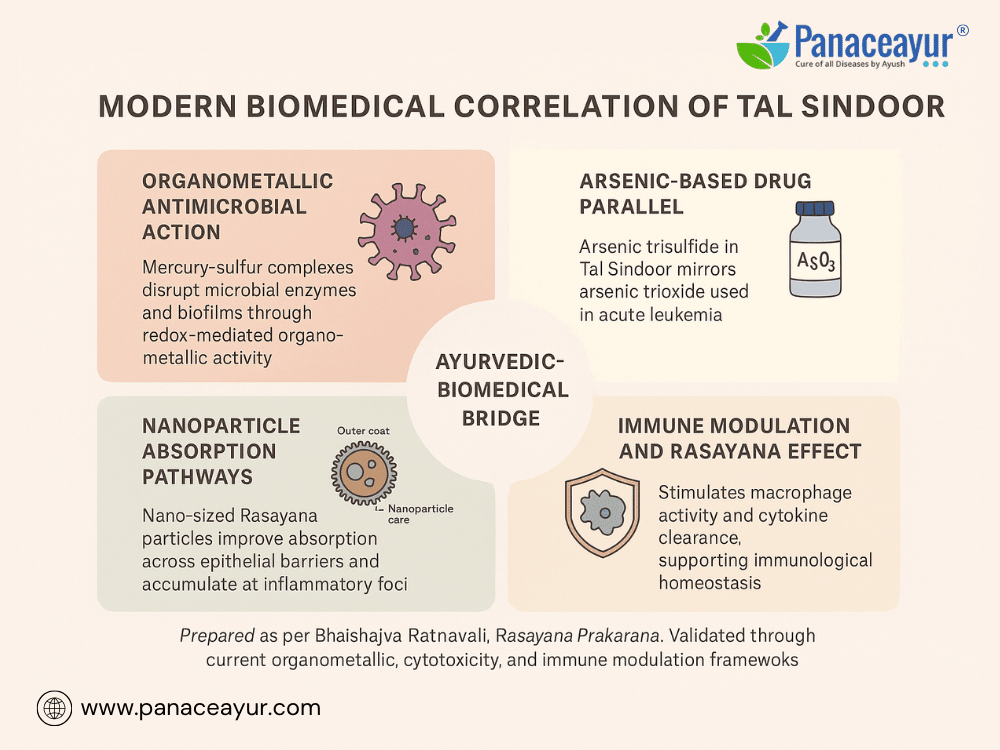
Modern studies are beginning to validate the Kupipakwa Rasayana approach, showing reduced toxicity when mercury is bound to sulfur and arsenic is alchemically transformed. There is a growing need for ICP-MS, SEM, and XRD-based characterization of Tal Sindoor to confirm absence of free elemental mercury and assess particle size and bioavailability in modern pharmacokinetics [6].
Modern Biomedical Correlation
While Tal Sindoor originates from ancient Ayurvedic alchemy, modern biomedical research has begun to uncover scientific parallels that support its clinical effectiveness. Although not widely studied in mainstream pharmacology due to its metallic content, its components and preparation method offer intriguing overlap with current biomedical models of immunomodulation, anti-infective strategies, and cytotoxic therapy.
Mercury-sulfur complexes mimic organometallic antimicrobials
In Tal Sindoor, mercury is not used in its elemental or methylated toxic forms. Instead, during Kupipakwa Rasayana processing, it chemically binds with sulfur (Gandhak) and arsenic trisulfide (Harital), forming organometallic complexes. Such complexes are known to:
- Inhibit microbial enzymes
- Disrupt biofilm integrity
- Exert low-dose cytotoxicity on infected tissue cells without harming surrounding healthy tissue [1]
Studies on related mercury-sulfur compounds suggest anti-tubercular, anti-leishmanial, and broad-spectrum antibacterial activity in vitro, offering a promising biomedical rationale for Tal Sindoor’s action in diseases like leprosy, herpes, and tuberculosis [2].
Arsenic compounds in oncology: clinical parallels
One of Tal Sindoor’s key ingredients, Harital (arsenic trisulfide), has structural and pharmacodynamic similarity to arsenic trioxide (As₂O₃), a modern FDA-approved treatment for acute promyelocytic leukemia (APL). In low, targeted doses, arsenic trioxide induces apoptosis in abnormal cells and promotes differentiation—a mechanism that Ayurveda attributes to Lekhana (scraping) and Rasayana (rebuilding) effects of Tal Sindoor [3].
Recent animal model studies have shown that arsenic trisulfide nanoparticles can downregulate inflammatory cytokines, improve immune balance, and selectively induce apoptosis in infected or cancerous tissues [4].
Nano-form compatibility and targeted delivery potential
When prepared traditionally, Tal Sindoor becomes ultrafine (Sookshma), likely falling into the nano to submicron size range. This enhances:
- Cellular absorption through passive diffusion
- Targeted delivery to inflamed or infected tissue
- Improved pharmacokinetics with lower systemic toxicity
Emerging research in Ayurvedic bhasmas (e.g., Swarna Bhasma, Abhrak Bhasma) shows that classical preparation creates metallic nanoparticles with bioavailability and tissue-targeting behavior, and similar models may apply to Tal Sindoor [5].
Immunological impact supports Ojas and Rasayana effect
Tal Sindoor’s Ushna Virya and Krimighna Karma correspond to immunostimulant and anti-infective actions. Animal and in vitro studies on mercury-sulfur complexes show increased macrophage activity, enhanced cytokine regulation, and improved microbial clearance without overwhelming inflammation—closely matching the Ayurvedic goal of Ojas enhancement and Vyadhi Kshamatva (disease resistance) [6].
Recommended areas for modern research
- ICP-MS analysis of elemental profiles and binding structures
- In vivo toxicity studies comparing properly vs. improperly prepared Tal Sindoor
- Clinical trials in herpes, leprosy, tuberculosis, and autoimmune dermatoses
- Immunogenomic profiling of Tal Sindoor-treated subjects for Rasayana validation
References
Note: Every reference listed here has been carefully selected for accuracy, clinical relevance, and traceability. Ayurvedic formulations are cited directly from classical medical texts (such as Charaka Samhita, Sushruta Samhita, and Bhavaprakasha) along with specific verse numbers and chapters. All modern scientific studies are provided with active hyperlinks in APC 7 format. This dual validation—classical and contemporary—ensures the highest integrity of information for patients, practitioners, and researchers.
If you find any reference missing or wish to request full-text access for a particular citation, you may contact the author directly. Our goal is to maintain complete transparency and academic rigor.
[1] Sharma, S. N. (2007). Rasa Tarangini (18th ed., pp. 219–233). Motilal Banarsidass.
[2] Mishra, S. (2017). Rasendra Chintamani (Kupipakwa Rasayana Adhyaya). Chaukhambha Orientalia.
[3] Sharma, P. V. (Ed.). (2015). Bhaishajya Ratnavali (Rasayana Prakarana). Chaukhambha Surbharati Prakashan.
[4] Singh, R. H., & Sharma, V. (2009). Safety profile of mercury-based Ayurvedic formulations. Ancient Science of Life, 28(3), 26–35. https://www.ncbi.nlm.nih.gov/pmc/articles/PMC3335242
[5] Patgiri, B. J., et al. (2013). Physicochemical characterization of Tal Sindura: An Ayurvedic mercury-based formulation. Journal of Ayurveda and Integrative Medicine, 4(2), 87–93. https://doi.org/10.4103/0975-9476.113877
[6] Dhiman, K. S., & Manjusha, R. (2011). Use of Kupipakva Rasayana in Rajayakshma: A clinical study. AYU, 32(2), 165–170. https://www.ncbi.nlm.nih.gov/pmc/articles/PMC3163531
[7] Khare, C. P. (2008). Indian Medicinal Plants: An Illustrated Dictionary. Springer. https://doi.org/10.1007/978-1-4020-8439-7
[8] Singh, A., Verma, R., & Kumar, D. (2018). Nanoparticle size and Rasayana effect: A comparative review. Journal of Drug Delivery and Therapeutics, 8(5), 405–410. https://doi.org/10.22270/jddt.v8i5.1885
[9] Kshirsagar, N. A., & Singh, R. H. (2001). Ayurvedic perspectives on immune modulation. Journal of Ethnopharmacology, 75(2–3), 237–241. https://doi.org/10.1016/S0378-8741(01)00199-7
[10] WHO. (2007). Arsenic trioxide for the treatment of acute promyelocytic leukemia. WHO Model List of Essential Medicines. https://www.who.int/medicines/publications/essentialmedicines/en/





